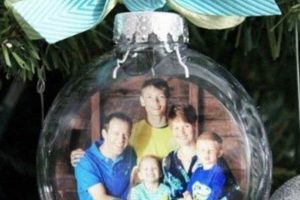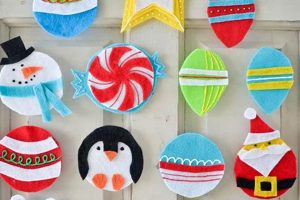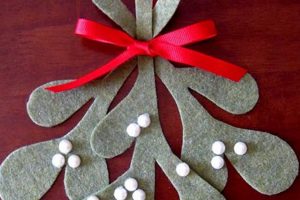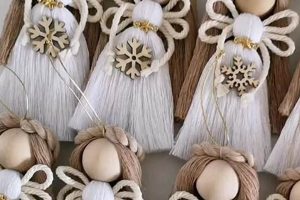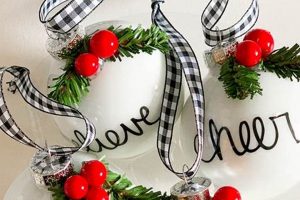Handcrafted decorative items incorporating small, perforated spheres threaded onto a string or wire, designed for suspension, represent a popular form of holiday adornment. These items are often created as personalized decorations for trees or other festive displays, and can range from simple, geometric shapes to complex, representational designs. For example, a star-shaped decoration crafted from various colored spheres and fine wire is a typical example.
The practice of creating custom decorations fosters creativity and provides a tangible connection to holiday traditions. The resulting ornaments can hold sentimental value, becoming cherished family heirlooms passed down through generations. Historically, handcrafted ornaments reflect cultural influences and individual artistic expression, offering a glimpse into past eras and personal histories. The act of creating these items also promotes mindfulness and fine motor skill development.
The following sections will explore the materials, techniques, and design considerations involved in the creation of these personalized holiday decorations. Furthermore, various styles and approaches, suitable for different skill levels and aesthetic preferences, will be examined.
Creating Effective Bead Ornaments
Achieving aesthetically pleasing and structurally sound beaded ornaments requires careful attention to detail and adherence to best practices. The following tips provide guidance for successful ornament creation.
Tip 1: Material Selection: Choose beads of uniform size and consistent color to ensure a balanced and professional appearance. Consider the weight of the chosen beads, particularly when creating larger ornaments, to prevent structural instability.
Tip 2: Wire Gauge: Select wire appropriate for the bead size and desired level of flexibility. Thicker gauge wire provides increased rigidity, while thinner gauge wire allows for more intricate designs. Copper or tarnish-resistant wire is recommended for longevity.
Tip 3: Secure Knotting Techniques: Employ secure knotting techniques, such as surgeon’s knots or square knots, to prevent unraveling. Incorporate adhesive, such as jewelry glue, at knotting points for added reinforcement, particularly for ornaments intended for long-term display.
Tip 4: Tension Management: Maintain consistent tension throughout the stringing process. Uneven tension can lead to distortion or breakage of the ornament. Periodically inspect the tension and adjust as needed.
Tip 5: Symmetry and Proportion: When designing symmetrical ornaments, ensure precise bead placement on both sides to maintain visual harmony. Consider the overall proportions of the ornament in relation to the intended display area.
Tip 6: Durable Finishing: Conceal wire ends securely within the beadwork or use crimp beads for a professional finish. Ensure all components are firmly attached to prevent detachment during handling or display.
Tip 7: Storage Considerations: Store ornaments in a cool, dry place, away from direct sunlight to prevent fading or deterioration. Use individual compartments or padded containers to prevent scratching or breakage during storage.
Adherence to these tips will contribute to the creation of visually appealing and structurally sound beaded ornaments, suitable for enduring holiday displays.
The following sections will explore advanced techniques and design inspirations to further enhance the creation of unique and personalized beaded ornaments.
1. Bead Material
The selection of bead material is a foundational element in the creation of handcrafted decorative ornaments. The material directly influences the ornament’s aesthetic characteristics, weight, durability, and overall cost. For instance, glass beads, known for their reflective qualities and wide range of colors, contribute to a visually sophisticated ornament but may be more fragile and expensive. Conversely, plastic beads offer affordability and resilience, making them suitable for ornaments intended for frequent handling or display in environments where breakage is a concern. Wood beads provide a natural, rustic aesthetic and can be easily painted or stained to achieve a desired color scheme. The material choice, therefore, necessitates a careful evaluation of the intended use and desired aesthetic outcome of the ornament.
Furthermore, the compatibility of the bead material with other components, such as wire or string, must be considered. Glass beads with sharp edges may require thicker, more durable wire to prevent cutting or abrasion. Lightweight plastic beads can be strung on thinner, more delicate threads, allowing for intricate designs without adding excessive weight. The use of mismatched materials can compromise the ornament’s structural integrity or detract from its visual appeal. For example, pairing heavy stone beads with thin, easily breakable string would likely result in structural failure. Therefore, a holistic approach to material selection is crucial for achieving a successful and lasting result.
In conclusion, bead material is a critical determinant of the quality, aesthetic, and longevity of handcrafted decorative ornaments. Informed material selection, based on a thorough understanding of material properties and design requirements, is essential for achieving desired outcomes. Overlooking this aspect can lead to aesthetically displeasing or structurally unsound ornaments. The deliberate choice of bead material serves as a cornerstone of successful ornament creation.
2. Wire Selection
Wire selection constitutes a critical determinant in the structural integrity, aesthetic presentation, and overall longevity of handcrafted decorative ornaments involving beads. The gauge, material, and temper of the chosen wire directly influence the ornament’s ability to maintain its shape, withstand handling, and resist corrosion or degradation over time.
- Gauge and Structural Support
The gauge of the wire, measured in American Wire Gauge (AWG), dictates its thickness and, consequently, its load-bearing capacity. A thinner gauge wire (e.g., 28 AWG) offers greater flexibility for intricate designs but may lack the strength to support heavier bead combinations. Conversely, a thicker gauge wire (e.g., 20 AWG) provides robust support but limits design complexity. For example, an ornament featuring large glass beads would necessitate a thicker gauge wire to prevent deformation or breakage under the beads’ weight. The selection of an appropriate gauge is thus crucial for ensuring the ornament’s structural stability.
- Material and Corrosion Resistance
The material composition of the wire influences its resistance to corrosion and tarnishing. Copper wire, while aesthetically pleasing with its warm tone, is prone to tarnishing unless coated with a protective layer. Silver-plated or gold-plated wire offers enhanced tarnish resistance but at a higher cost. Stainless steel wire provides excellent corrosion resistance and strength, making it suitable for ornaments intended for outdoor display or frequent handling. The selection of a wire material with adequate corrosion resistance ensures the ornament maintains its aesthetic appeal over time and minimizes the need for frequent cleaning or replacement.
- Temper and Workability
The temper of the wire refers to its hardness and flexibility. Dead soft wire is highly malleable and easily shaped, ideal for intricate designs but lacks rigidity. Half-hard wire offers a balance between workability and strength, suitable for general ornament construction. Full-hard wire is the strongest but requires specialized tools for shaping. Selecting the appropriate temper is crucial for facilitating the ornament construction process. For example, using a full-hard wire for intricate beadwork would prove difficult and potentially damage the beads.
- Color and Aesthetic Integration
Wire color contributes to the overall aesthetic of the beaded ornament. Silver, gold, copper, and black wires are commonly used, each offering a distinct visual effect. The wire can be intentionally visible as part of the design or concealed within the beadwork to minimize its presence. The choice of wire color should complement the colors of the beads and other embellishments used in the ornament. A harmonious color palette enhances the overall visual appeal of the finished piece.
In summary, wire selection is a multifaceted consideration in the creation of handcrafted beaded ornaments. Careful attention to gauge, material, temper, and color ensures the ornament’s structural integrity, resistance to degradation, and aesthetic coherence. A thoughtful approach to wire selection elevates the quality and longevity of these decorative items.
3. Design Complexity
Design complexity in the context of handcrafted bead ornaments refers to the level of intricacy and detail incorporated into the ornament’s structure and aesthetic composition. The complexity of a design directly influences the time, skill, and resources required for its creation. Simple designs, characterized by basic geometric shapes and minimal bead variations, can be readily executed by novice crafters with limited experience. Conversely, complex designs, incorporating intricate patterns, representational figures, or elaborate embellishments, demand advanced techniques and a higher degree of precision. For example, a simple star-shaped ornament made with uniformly sized and colored beads represents a low level of design complexity, while a three-dimensional beaded animal figure requires significant design planning and construction skills.
The importance of design complexity lies in its impact on the aesthetic value, personalization, and perceived craftsmanship of the ornament. A well-executed complex design demonstrates a higher level of skill and attention to detail, resulting in a visually striking and unique piece. Furthermore, design complexity allows for greater personalization, enabling crafters to express individual artistic styles and incorporate specific themes or motifs. Consider the difference between a simple beaded ball and a complex beaded snowflake, each expressing a distinct aesthetic and level of craftsmanship. Understanding design complexity is also crucial for selecting appropriate materials and techniques. Intricate designs often require specialized tools and materials, such as fine-gauge wire, small beads, and precise knotting techniques.
The consideration of design complexity is paramount in the successful creation of handcrafted bead ornaments. Overestimating one’s skill level or underestimating the time and resources required for a complex design can lead to frustration and unsatisfactory results. Therefore, it is advisable to begin with simpler designs and gradually progress to more complex projects as skills and confidence develop. By carefully considering design complexity, crafters can ensure a rewarding and enjoyable experience while creating beautiful and personalized decorative ornaments. The recognition of the link between skill level, available resources, and intended design complexity significantly increases the likelihood of a successful project.
4. Color Palette
The selection and application of a color palette is a pivotal aspect of creating handcrafted bead ornaments, significantly influencing the ornament’s visual impact, emotional resonance, and overall aesthetic appeal. A well-considered color palette elevates the ornament from a mere craft project to a cohesive work of art, reflecting deliberate design choices and enhancing its perceived value.
- Harmony and Contrast
The deliberate interplay of harmonious and contrasting colors forms the foundation of an effective color palette. Harmonious color combinations, such as analogous colors (colors adjacent to each other on the color wheel), create a sense of unity and visual coherence. Conversely, contrasting colors, such as complementary colors (colors opposite each other on the color wheel), introduce visual interest and dynamic tension. For example, an ornament employing shades of blue and green evokes a sense of tranquility, while an ornament combining red and green creates a vibrant, festive atmosphere. The strategic use of both harmony and contrast allows for the creation of visually engaging and balanced ornaments.
- Seasonal and Thematic Relevance
The color palette should align with the intended seasonal or thematic context of the ornament. Traditional Christmas ornaments often feature red, green, and gold, evoking a sense of holiday cheer and tradition. Ornaments intended for a winter theme may incorporate shades of blue, silver, and white to reflect the cold and icy landscape. Pastel colors are commonly used for spring-themed ornaments, symbolizing new beginnings and growth. The selection of colors that resonate with the intended theme enhances the ornament’s symbolic meaning and strengthens its connection to the viewer.
- Material Considerations
The inherent color and texture of the bead materials themselves must be considered when developing the color palette. Glass beads, with their inherent transparency and reflectivity, interact with light differently than opaque plastic or wood beads. Metallic beads introduce a shimmering effect that can be either complementary or disruptive to the overall palette. For example, the use of iridescent beads can add a subtle shimmer to a monochromatic palette, while the inclusion of overly bright metallic beads can overwhelm the design. The material properties of the beads should inform the selection of colors to ensure a cohesive and visually harmonious result.
- Personal Expression and Style
While adherence to design principles is important, the color palette also offers an opportunity for personal expression and stylistic choices. Individual preferences for color combinations and aesthetic sensibilities should be incorporated into the design. Some crafters may prefer a minimalist approach with a limited color palette, while others may embrace a more eclectic and vibrant approach. The color palette should ultimately reflect the crafter’s unique vision and create an ornament that is both visually appealing and personally meaningful. A balance between established design principles and individual creative expression results in unique and personalized creations.
In conclusion, the selection of a deliberate and thoughtfully considered color palette is essential for elevating handcrafted bead ornaments. The strategic use of harmony, seasonal relevance, material considerations, and personal expression transforms a simple craft project into a visually compelling and emotionally resonant work of art. A well-chosen color palette enhances the ornament’s aesthetic appeal, reinforces its thematic significance, and reflects the crafter’s individual style, resulting in a truly unique and cherished decorative item.
5. Attachment Method
The means by which a handcrafted bead ornament is affixed to its intended display surface significantly influences its overall presentation, security, and aesthetic integration. The attachment method is, therefore, a critical design consideration that warrants careful selection based on factors such as ornament weight, intended display location, and desired aesthetic effect. Inadequate attachment can lead to damage, loss of the ornament, or a compromised visual presentation.
- Wire Loops and Hooks
The use of wire loops, formed from the same or a complementary wire used in the ornament’s construction, represents a common and versatile attachment method. A loop is created at the top of the ornament and secured with a knot or crimp bead, allowing for the attachment of a separate hook or the direct placement onto a tree branch. The wire’s gauge and composition should be sufficient to support the ornament’s weight. An example is the use of a 22-gauge copper wire loop to suspend a lightweight glass bead ornament. Improperly secured loops can detach, causing the ornament to fall.
- Ribbon or Cord Hangers
Ribbon or cord hangers provide an alternative attachment method, offering a range of aesthetic possibilities through variations in material, color, and texture. A ribbon or cord is threaded through the top of the ornament and tied to create a loop. The material should be durable and resistant to fraying. For instance, a velvet ribbon adds a luxurious touch to a beaded ornament, while a simple cotton cord provides a more rustic aesthetic. An example is the use of a satin ribbon to hang a delicate beaded snowflake ornament. Failure to properly secure the ribbon or cord can result in slippage or detachment.
- Adhesive-Based Attachments
Adhesive-based attachments involve the direct bonding of the ornament to a surface using glue or adhesive pads. This method is typically suitable for lightweight ornaments intended for permanent display on flat surfaces. The adhesive should be compatible with both the ornament material and the target surface to ensure a secure bond. An example is the use of double-sided adhesive pads to attach small beaded embellishments to a windowpane. Improper adhesive selection or application can lead to detachment and damage to the ornament or the surface it is attached to.
- Integrated Ornament Stands
Integrated ornament stands provide a freestanding display option for beaded ornaments. The ornament is designed with a base or support structure that allows it to stand upright on a table or shelf. This method eliminates the need for hanging and offers greater flexibility in placement. An example is a beaded star ornament with a wire frame base that allows it to stand independently. The stability of the stand is crucial to prevent the ornament from toppling over.
The selection of an appropriate attachment method for diy bead ornaments necessitates a careful assessment of the ornament’s characteristics, the intended display environment, and the desired aesthetic effect. Each method presents unique advantages and limitations that must be considered to ensure the secure, visually pleasing, and long-lasting presentation of the handcrafted item. The attachment method directly impacts the perceived value and utility of the finished beaded ornament.
6. Ornament Size
The physical dimensions of handcrafted bead ornaments, designated as “Ornament Size,” exert a considerable influence on various aspects of their design, creation, and display. The scale of these decorative items impacts material requirements, structural integrity, aesthetic impact, and logistical considerations related to storage and handling. Therefore, careful consideration of size is paramount during the planning and execution phases of a bead ornament project.
- Material Consumption and Cost
Ornament size directly correlates with the quantity of materials required for its construction. Larger ornaments necessitate a greater number of beads, wire, and other embellishments, thereby increasing the overall cost of the project. For instance, creating a spherical ornament with a 10-centimeter diameter will require significantly more beads than a similar ornament with a 5-centimeter diameter. The economic implications of size should be considered, particularly when producing multiple ornaments or working within budgetary constraints. Inefficient material utilization in larger ornaments can lead to substantial cost overruns.
- Structural Stability and Weight Distribution
The size of a bead ornament influences its structural stability and weight distribution. Larger ornaments are inherently more susceptible to structural failure due to the increased weight of the constituent beads. Reinforcement techniques, such as using heavier gauge wire or incorporating internal support structures, may be necessary to ensure the ornament retains its shape and integrity. Uneven weight distribution within a larger ornament can cause it to hang improperly or become unstable. Achieving balance and structural soundness in larger ornaments presents a significant design challenge.
- Visual Impact and Display Context
Ornament size plays a crucial role in its visual impact and suitability for different display contexts. Larger ornaments command greater attention and can serve as focal points within a holiday display. However, their size may also limit their placement options, particularly on smaller trees or in confined spaces. Smaller ornaments, while less visually dominant, offer greater versatility in terms of display location. The intended display environment should inform the choice of ornament size to ensure it complements the overall aesthetic and spatial constraints. A large ornament on a small tree can appear disproportionate and overwhelming.
- Complexity of Design and Execution
Ornament size can directly affect the ease or difficulty of the design and execution. Larger formats permit more intricate designs but may require additional physical endurance and time due to the increased number of components and complex assembly. In contrast, smaller forms may require simplification of complex designs to fit within the restricted size constraints, thereby demanding an innovative approach to retain visual details. Handling minute components for smaller ornaments can also pose a challenge, especially for those with limited dexterity. Therefore, a balance must be struck between design ambitions, physical limitations, and the feasible handling of the intended ornament size.
In conclusion, the selection of an appropriate “Ornament Size” is a critical decision in the creation of handcrafted bead ornaments. The size determines the material costs, structural requirements, visual impact, and the level of design complexity achievable. A thorough understanding of these factors enables the creation of well-proportioned, visually appealing, and structurally sound decorative items that enhance the aesthetic of their intended display environment.
7. Durability Enhancement
Durability enhancement is a crucial consideration in the construction of handcrafted beaded ornaments, directly affecting their longevity and ability to withstand handling, environmental factors, and the passage of time. The selection of appropriate materials and the application of specific techniques serve as primary methods for bolstering an ornament’s resistance to damage, thereby ensuring its enduring aesthetic appeal and sentimental value. Neglecting durability during the creation process often leads to premature degradation, diminishing the ornament’s lifespan and necessitating repairs or replacement.
Techniques for durability enhancement include the selection of tarnish-resistant wire, such as stainless steel or coated copper, to mitigate corrosion. Knotting beads securely with strong, abrasion-resistant threads minimizes the risk of unraveling or breakage. Applying sealant or varnish to wooden beads protects them from moisture damage and fading. Using high-quality adhesives at key connection points, such as where wire loops attach to the main body of the ornament, reinforces structural integrity. For instance, an ornament constructed with inexpensive, uncoated wire and loosely strung beads will likely deteriorate quickly, while one utilizing robust materials and secure fastening methods can withstand years of handling and display. Similarly, glass beads of greater thickness are naturally more impact resistant and less prone to shatter than thinner counterparts.
In summary, durability enhancement plays an essential role in extending the functional and aesthetic lifespan of handcrafted beaded ornaments. The implementation of suitable materials and techniques bolsters resistance to damage caused by handling, storage, and environmental conditions. Ultimately, a proactive approach to durability during the crafting process ensures that these personalized decorative items endure as cherished keepsakes, preserving memories and traditions for generations to come.
Frequently Asked Questions
This section addresses common inquiries regarding the creation, maintenance, and longevity of handcrafted beaded ornaments, providing guidance for both novice and experienced crafters.
Question 1: What types of beads are most suitable for creating durable ornaments?
Durable ornaments benefit from the use of materials resistant to chipping, cracking, or fading. Glass beads, particularly those made from borosilicate glass, offer high durability and resistance to thermal shock. Acrylic beads, while less visually appealing than glass, provide excellent impact resistance. Wooden beads, when properly sealed with a protective coating, can also be used effectively. Bead selection should be based on a balance of aesthetic considerations and durability requirements.
Question 2: How can the structural integrity of beaded ornaments be maximized?
Structural integrity is primarily determined by the quality of the stringing material and the tightness of the knots. High-strength beading wire, such as those made from stainless steel or nylon-coated steel, provides superior resistance to breakage. Employing secure knotting techniques, such as surgeon’s knots or square knots, prevents slippage and unraveling. Incorporating crimp beads or bead tips at the ends of the stringing material further enhances structural stability. Proper tension during stringing is essential to prevent sagging or distortion.
Question 3: What steps can be taken to prevent beaded ornaments from tarnishing or fading?
Tarnishing is primarily a concern with metallic beads and findings. Selecting tarnish-resistant materials, such as sterling silver or gold-filled beads, minimizes this issue. Applying a protective coating, such as a clear acrylic spray or anti-tarnish solution, provides an additional barrier against oxidation. Fading can be mitigated by storing ornaments in a cool, dark place away from direct sunlight. Certain dyes used in colored beads are more susceptible to fading than others; opting for high-quality, lightfast dyes can prolong color vibrancy.
Question 4: Is there a recommended method for cleaning beaded ornaments?
Cleaning beaded ornaments requires a delicate approach to avoid damaging the beads or stringing material. Gentle dusting with a soft brush or cloth is generally sufficient for removing surface dirt. For more stubborn stains, a mild soap solution can be used, applied sparingly with a damp cloth. Avoid immersing the ornament in water, as this can weaken the stringing material or cause beads to lose their luster. Allow the ornament to air dry completely before storing.
Question 5: How should beaded ornaments be stored to prevent damage?
Proper storage is essential for preserving the condition of beaded ornaments. Individual storage in padded containers or zippered plastic bags prevents scratching and tangling. Placing silica gel packets within the storage containers helps absorb moisture and prevent mold growth. Avoid storing ornaments in excessively hot or humid environments, as this can damage the beads or stringing material. Proper packing ensures the ornaments can be enjoyed year after year.
Question 6: What are some advanced techniques for creating complex beaded ornament designs?
Creating complex designs often involves techniques such as bead weaving, bead embroidery, or three-dimensional construction using wire framing. Bead weaving involves interlacing beads to create intricate patterns and textures. Bead embroidery involves stitching beads onto a fabric backing to create detailed designs. Three-dimensional construction requires careful planning and precise wire manipulation to create sculptural forms. Mastering these techniques requires practice and experimentation.
These FAQs provide a foundation for understanding the key considerations involved in creating and maintaining durable and visually appealing beaded ornaments. Careful attention to material selection, construction techniques, and storage practices will ensure the longevity of these cherished decorative items.
The subsequent sections will explore creative design ideas and project tutorials for crafting unique beaded ornaments.
Conclusion
The preceding exploration of diy bead ornaments has elucidated the multifaceted nature of this craft, encompassing material selection, design complexity, construction techniques, and long-term maintenance. Emphasis has been placed on the criticality of informed decision-making throughout the creative process, from initial conception to final execution, to ensure the production of durable, aesthetically pleasing, and personally meaningful decorative items. The interplay of factors such as wire gauge, bead material, color palette, and attachment method, has been thoroughly examined, providing a comprehensive framework for successful ornament creation.
The creation of diy bead ornaments represents a tangible intersection of artistic expression and practical skill, offering an avenue for personal creativity and the preservation of time-honored traditions. Continued exploration and refinement of these techniques will undoubtedly contribute to the evolution of this craft and its enduring appeal as a means of enhancing personal spaces and celebrating cultural heritage. The dedication to quality and craftsmanship ensures that each creation stands as a testament to individual skill and artistic vision.


